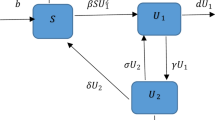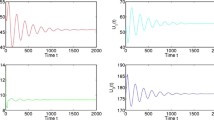Abstract
In this paper, a nonlinear mathematical model of illicit drug use in a population is studied using dynamical system theory. The work is largely concerned with the analysis of asymptotic behaviour of solutions to a six-dimensional system of differential equations modeling the influence of illicit drug use in the population. The model is mathematically well-posed based on positivity and boundedness of solutions. A key threshold which measures the potential spread of the illicit drug use in the population is derived analytically. The model is shown to exhibit forward bifurcation property, implying the existence, uniqueness and local stability of an illicit drug-present equilibrium. Furthermore, the global asymptotic dynamics of the model around the illicit drug-free and drug-present equilibria are extensively investigated using appropriate Lyapunov functions. Numerical simulations are carried out to complement the obtained theoretical results, and to examine the effects of some parameters, such as influence rate, rehabilitation rates of drug users and relapse rate, on the dynamical spread of illicit drug use in the population. Measures to guide against the menace of the illicit drug use are suggested.




Similar content being viewed by others
References
World Health Organization (WHO), Biregional Strategy for Harm Reduction 2005–2009: HIV and Injecting Drug Use. https://apps.who.int/iris/handle/10665/204820. Accessed 20 Nov 2019
World Health Organization (WHO), Substance Abuse, Facts and Figures. http://www.who.int/substance_abuse/facts/en/. Accessed 12 June 2020
Giovino, G.A.: Epidemiology of tobacco use in the United States. Oncogene 21(48), 7326–7340 (2002)
Haladu, A.A.: Outreach strategies for curbing drug abuse among out-of-school youth in Nigeria: a challenge for community based organization. In: Garba, A. (ed.) Youth and Drug Abuse in Nigeria: Strategies for Counselling, Management and Control. Matosa Press, Kano (2003)
Fareo, D.O.: Drug abuse among Nigerian Adolescents strategies for counseling. J. Int. Soc. Res. 20(5), 1307–9581 (2012)
National Association for Mental Health, Understanding the mental health effects of recreational drugs and alcohol. https://www.mind.org.uk/information-support/types-of-receational-drug/. Accessed 11 May 2020
Helbing, D., Brockmann, D., Chadefaux, T., Donnay, K., Blanke, U., et al.: Saving human lives: what complexity science and information systems can contribute. J. Stat. Phys. 158, 735–781 (2015)
Castillo-Garsow, C., Jordan-Salivia, G., Rodriguez-Herrera, A.: Mathematical models for the dynamics of tobacco use, recovery and relapse. Technical Report Series BU-1505-M, Cornell University, NY (1997)
Behrens, D.A., Caulkins, J.P., Tragler, G., Haunschmied, J.L., Feichtinger, G.: A dynamic model of drug initiation: implications for treatment and drug control. Math. Biosci. 159, 1–20 (1999)
White, E., Comiskey, C.: Heroin epidemics, treatment and ODE modeling. Math. Biosci. 208, 312–324 (2007)
Kalula, A.S., Nyabadza, F.: A theoretical model for substance abuse in the presence of treatment. South Afri. J. Sci. 108, 1–12 (2012)
Mushayabasa, S., Tapedzesa, G.: Modeling illicit drug use dynamics and its optimal control analysis. Comput. Math. Methods Med. (2015). https://doi.org/10.1155/2015/383154
Kanyaa, J.K., Osman, S., Wainaina, M.: Mathematical modelling of substance abuse by commercial drivers. Glob. J. Pure. Appl. Math. 14(9), 1149–1165 (2018)
Ginoux, J.-M., Naeck, R., Ruhomally, Y.B., Dauhoo, M.Z., Matjaž, P.: Chaos in a predator-prey-based mathematical model for illicit drug consumption. Appl. Math. Comput. 347, 502–513 (2019)
Bae, Y.: Chaotic dynamics in tobacco’s addiction model. Int. J. Fuzzy. Logic. Intell. Syst. 14, 322–331 (2014)
Nyabadza, F., Coetzee, L.: A systems dynamic model for drug abuse and drug-related crime in western cape province of South Africa. Comput. Math. Methods. Med. (2017). https://doi.org/10.1155/2017/4074197
Hotton, T., Haans, D.: Alcohol and drug use in early adolescence. Health. Rep. 15(3), 9–19 (2004)
Mushanyuzy, J., Nyabadza, F., Muchatibayaz, G., Stewartz, A.G.R.: The role of family in initiating methamphetamine abuse treatment: insight through a mathematical model. J. Appl. Comput. Math. 5, 1000290 (2016)
Orwa, T.O., Nyabadza, F.: Mathematical modelling and analysis of alcohol-methamphetamine co-abuse in the western cape province of South Africa. Cogent. Math. Stat. 6, 1641175 (2019)
Khajanchi, S., Matjaž, P., Ghosh, D.: The influence of time delay in a chaotic cancer model. Chaos 28, 103101 (2018)
Silva, P.H.O., Nardo, L.G., Martins, S.A.M., Nepomuceno, E.G., Matjaž, P.: Graphical interface as a teaching aid for nonlinear dynamical systems. Eur. J. Phys. 39(6), 065105 (2018). https://doi.org/10.1088/1361-6404/aae35c
Smith, H.L., Walman, P.: The Theory of the Chemostat. Cambridge University Press, Cambridge (1995)
Hethcote, H.W.: The mathematics of infectious diseases. SIAM Rev. 42(4), 599–653 (2000)
van den Driessche, P., Watmough, J.: Reproduction numbers and sub-threshold endemic equilibria for compartmental models of disease transmission. Math. Biosci. 180, 29–48 (2002)
Olaniyi, S., Lawal, M.A., Obabiyi, O.S.: Stability and sensitivity analysis of a deterministic epidemiological model with pseudo-recovery. IAENG Int. J. Appl. Math. 46(2), 160–167 (2016)
Castillo-Chavez, C., Song, B.: Dynamical models of tuberculosis and their applications. Math. Biosci. Eng. 1, 361–404 (2004)
LaSalle, J.P.: The Stability of Dynamical Systems. Regional Conference Series in Applied Mathematics. SIAM, Philadelphia (1976)
Ghosh, M., Olaniyi, S., Obabiyi, O.S.: Mathematical analysis of reinfection and relapse in malaria dynamics. Appl. Math. Comput. 373, 125044 (2020)
Safi, M.A.: Global dynamics of treatment models with time delay. Comput. Appl. Math. 34, 325–341 (2015)
Akanni, J.O., Akinpelu, F.O., Olaniyi, S., Oladipo, A.T., Ogunsola, A.W.: Modelling financial crime population dynamics: optimal control and cost-effectiveness analysis. Int. J. Dyn. Control 8, 531–544 (2020)
Bonyah, E., Khan, M.A., Okosun, K.O., Gómez-Aguilar, J.F.: On the co-infection of dengue fever and Zika virus. Optim. Control. Appl. Methods 40, 394–421 (2019)
Obabiyi, O.S., Olaniyi, S.: Global stability analysis of malaria transmission dynamics with vigilant compartment. Electron. J. Differ. Equ. 2019, 1–10 (2019)
Olaniyi, S., Okosun, K.O., Adesanya, S.O., Areo, E.A.: Global stability and optimal control analysis of malaria dynamics in the presence of human travelers. Open. Infect. Dis. 10, 166–186 (2018)
Acknowledgements
The authors thank the editor and anonymous reviewers whose valuable and insightful comments have helped to improve the original manuscript.
Author information
Authors and Affiliations
Corresponding author
Additional information
Publisher's Note
Springer Nature remains neutral with regard to jurisdictional claims in published maps and institutional affiliations.
Rights and permissions
About this article
Cite this article
Akanni, J.O., Olaniyi, S. & Akinpelu, F.O. Global asymptotic dynamics of a nonlinear illicit drug use system. J. Appl. Math. Comput. 66, 39–60 (2021). https://doi.org/10.1007/s12190-020-01423-7
Received:
Revised:
Accepted:
Published:
Issue Date:
DOI: https://doi.org/10.1007/s12190-020-01423-7




